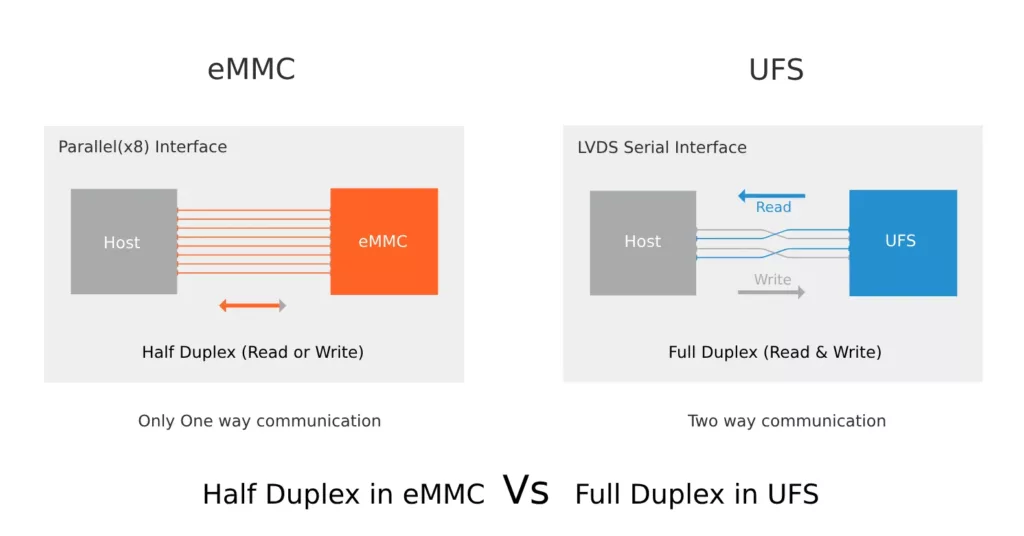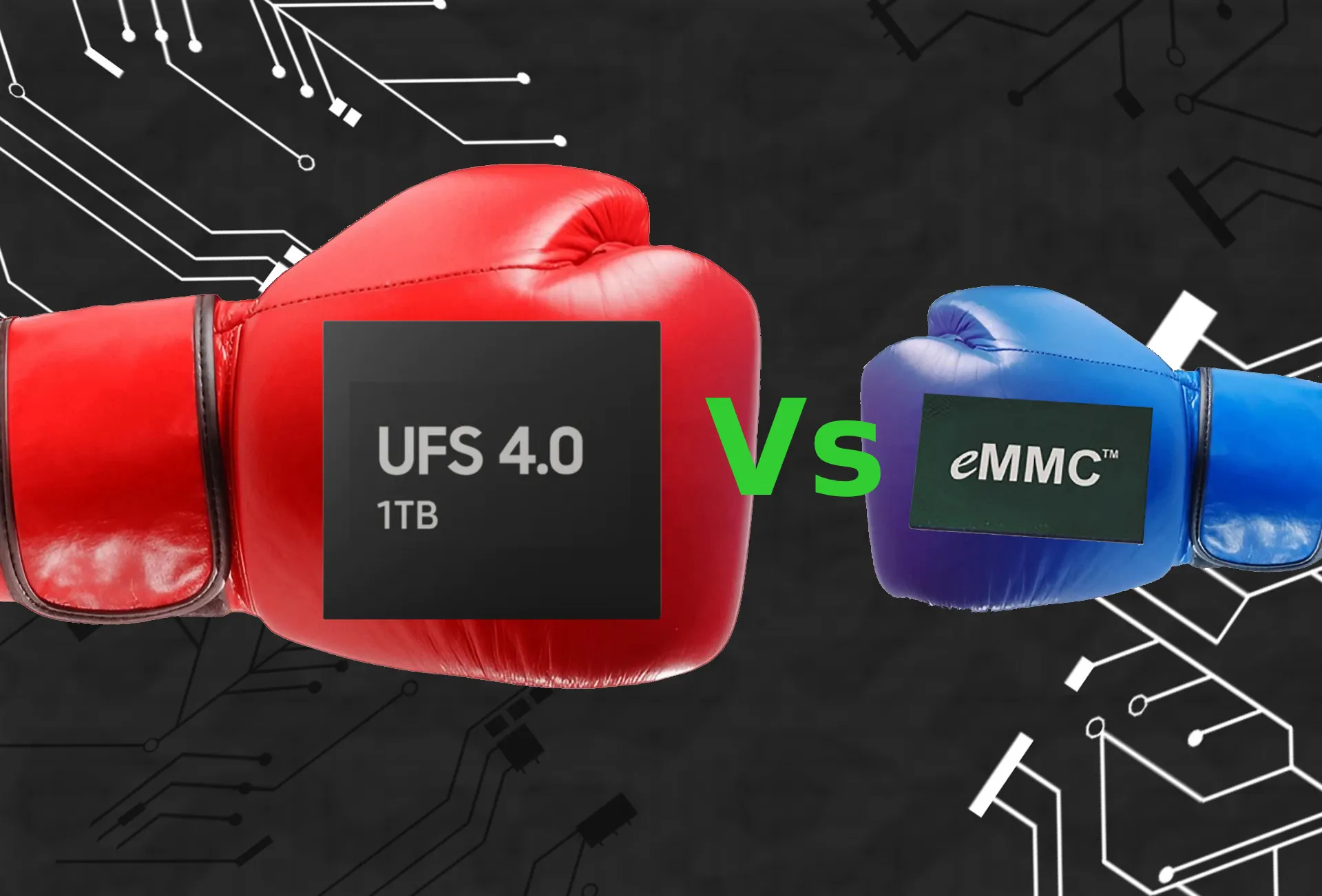Last Updated on October 23, 2025 by Team Yantra
Both eMMC and UFS memory are playing a role in our digital lives that goes beyond mere functionality.
Both eMMC and UFS are a type of storage technology used to store information in our smartphones, tablets, and other mobile computing devices.
Let us understand both eMMC and UFS regarding their speed, performance, energy consumption and Why UFS is completely replacing eMMC.
The basics – NAND FLASH
To start with, before understanding eMMC and UFS, there is NAND Flash. At the heart of modern storage solutions is NAND Flash memory, a storage technology that emerged to counter the limitations of traditional spinning hard drives. The common SSDs you find in laptops are also based on NAND flash memory.
NAND Flash is the Gold standard for storing data, period.
Further, refining this, managed NAND—a specialized version of NAND flash memory—incorporates a controller to manage firmware, streamlining data operations.
Today, the arena of managed NAND in the world of smartphones has two key players: eMMC (Embedded MultiMediaCard) and UFS (Universal Flash Storage).
UFS and eMMC are a type of managed NAND Flash. The main component, NAND flash, remains the same, but the difference arises in how they control that NAND Flash.
What is eMMC Memory?
eMMC – Embedded Multimedia card is a simple storage device which uses NAND flash memory. It is used in low budget mobile phones, tablets, eReaders, GPS and other mobile computing devices.
eMMC is a type of managed NAND flash memory, which is a combination of NAND Flash memory and Flash memory controller.
The latest eMMC standard is version 5.1.
The eMMC (embedded MultiMediaCard) uses an 8-bit parallel interface for data transfer. This means it can send or receive 8 bits of data.
But, eMMC operates in a half-duplex mode, meaning it can either read or write data at any given time, not both simultaneously.
What is UFS memory?
UFS – Universal Flash storage is an advanced high-performance storage component. It is used in smartphones, tablets, and digital cameras. It offers fast data transfer rates and high processing speeds, improving overall device performance.
The current latest, in use version of UFS is UFS v4.1 which is a mid-update to UFS v4.0. UFS v4.1 was announced in January 2025 . The memory chips with UFS v4.1 are now available from Kioxia, Sk hynix (321-layer) was then designed. The UFS v4.1 is currently in use in Latest smartphones like Samsung Galaxy S25 ultra etc.
The upcoming version of UFS – UFS v5 is announced by JEDEC with double the performance of UFS v4.0/4.1. But the actual hardware memory chips from companies like Kioxia, Samsung and SK Hynix etc are yet to be launched
Like eMMC, UFS is also a type of Managed Flash memory and combines NAND flash memory and a controller. But, UFS has additional technological advancements which makes it faster, more power efficient and efficient than eMMC
UFS uses a serial interface called MIPI M-PHY, which is different from the parallel interface used by eMMC.
The M-PHY interface operates in Full Duplex mode, meaning it supports multiple lanes for simultaneous data transmission and reception.
This means UFS can read and write data at the same time, significantly improving data transfer speeds compared to eMMC.
If you’re interested in knowing further about UFS v4.0 we have covered in-depth in our UFS explained Article.
Key differences between eMMC and UFS:
- Speed: The most significant advantage of UFS over eMMC is speed.
- Power Efficiency: UFS also outperforms eMMC in terms of power efficiency.
- Cost: Although eMMC is generally more affordable, UFS offers superior performance and power efficiency, which many users find worth the additional cost.
- Technical Differences: UFS employs a serial interface and a Command Queue, allowing for multiple commands to be processed simultaneously, whereas eMMC uses a parallel interface that handles one command at a time.
- Advanced Features: UFS supports features like Deep Sleep, Write Booster, and thermal throttling notifications, which aren’t available in eMMC.
| Features | eMMC 5.1 | UFS v4.0 |
|---|---|---|
| Year of Introduction | 2015 | 2020 |
| Interface | Parallel (x8) | LVDS Serial |
| Data Transfer | Half Duplex (Either read or write) | Full Duplex (Both read and write at a time) |
| Sequential Read (MB/s) | 250 | 4200 |
| Sequential Write (MB/s) | 125 | 2800 |
| Latency (i.e., data transfer time) | More | Less |
| Performance | Low | Higher |
| Power Consumption | More | Less |
| Bandwidth (of data transfer) | Lower | Higher |
Let’s go into the reasons for these differences.
Speed:
Reasons that contribute to high speeds of UFS compared to eMMC
- Interface –
- UFS employs an M-PHY based serial interface and a Command Queue, allowing for multiple commands to be processed simultaneously, whereas eMMC uses a parallel interface that handles one command at a time.
- Full Duplex in UFS Vs Half Duplex in eMMC –
- eMMC operates in a half-duplex mode, which means it can either read or write data at a given time. In contrast, UFS operates in a full-duplex mode, enabling it to read and write data simultaneously, which significantly improves performance.

Power Efficiency: Saving Battery Life
UFS also outperforms eMMC in terms of power efficiency. UFS uses M-PHY interface which uses a type of LVDS (Low-Voltage Differential Signaling) technology, which results in lower power consumption compared to the high-speed signaling technology used in eMMC. This difference can contribute to improved battery life in devices.
Cost: Affordability vs. Performance
eMMC has been around for a while, which has allowed its manufacturing process to be fine-tuned, resulting in lower costs. UFS, being a newer technology, comes at a higher price point. However, with the increased performance and power efficiency, many consider it a worthy investment.
Advanced Features:
UFS supports advanced features that aren’t available in eMMC.
These include Deep Sleep, which minimizes power consumption when the device is inactive;
Write Booster, which enhances writing speed by using a portion of the RAM as a write buffer, and throttling notifications that alert the host when the storage device’s performance is reduced due to thermal throttling.
These features not only boost performance but also contribute to improved device health and longevity.
Why will UFS completely replace eMMC?
While some industries like embedded, automobile etc. are employing eMMC memory due to its low-cost and good reliability.
Advance devices like smartphones, tablets, and automobiles are moving forward to completely replace eMMC with UFS. Due to high speeds and low-power consumption requirements.
There are other reasons as well, like
eMMC has been abandoned.
eMMC memory has not been upgraded since 2015 when eMMC 5.1 was announced. The organization behind eMMC is JEDEC which is also introduced UFS.
Since the last eMMC version 5.1 was released in 2015, and UFS has received continues updates like UFS v3.1 in 2019, UFS v4.0 in 2022.
It would be correct to say JEDEC is not much focusing on eMMC and chosen UFS as the successor
UFS is the successor of the eMMC standard used as embedded NAND flash memory.

Leave a Reply
You must be logged in to post a comment.